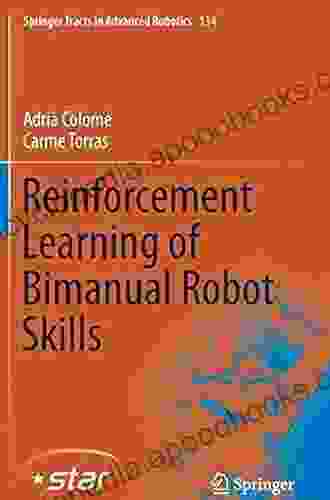Reinforcement Learning of Bimanual Robot Skills: A Comprehensive Guide

4 out of 5
| Language | : | English |
| File size | : | 43813 KB |
| Text-to-Speech | : | Enabled |
| Enhanced typesetting | : | Enabled |
| Print length | : | 273 pages |
| Screen Reader | : | Supported |
Bimanual robots are robots that have two arms and hands. They are often used in manufacturing and other industries where they can perform tasks that are difficult or impossible for humans to do. Reinforcement learning is a type of machine learning that allows robots to learn how to perform tasks by trial and error. This article provides a comprehensive overview of reinforcement learning techniques for bimanual robot skills, including theoretical foundations, algorithms, and applications.
Theoretical Foundations
Reinforcement learning is a subfield of machine learning that deals with learning how to take actions in an environment in Free Download to maximize a reward. The environment is typically modeled as a Markov decision process (MDP),which is a mathematical framework that describes the dynamics of the environment and the rewards that are associated with different actions. The goal of reinforcement learning is to find a policy, which is a mapping from states to actions, that maximizes the expected reward over time.
There are a number of different reinforcement learning algorithms that can be used to learn bimanual robot skills. Some of the most common algorithms include:
- Q-learning
- SARSA
- Actor-critic methods
- Policy gradient methods
The choice of which algorithm to use depends on the specific task that is being learned. For example, Q-learning is a good choice for tasks where the state space is small and the reward function is simple. SARSA is a good choice for tasks where the state space is large and the reward function is complex. Actor-critic methods are a good choice for tasks where the action space is continuous. Policy gradient methods are a good choice for tasks where the policy is high-dimensional.
Algorithms
The following are some of the most common reinforcement learning algorithms that are used to learn bimanual robot skills:
- Q-learning is a value-based reinforcement learning algorithm that estimates the value of each state-action pair. The value of a state-action pair is the expected reward that will be obtained by taking that action in that state. Q-learning updates the value of each state-action pair by taking the average of the current value and the value of the next state, weighted by the probability of taking that action in that state.
- SARSA is a model-free reinforcement learning algorithm that estimates the value of each state-action pair. SARSA updates the value of each state-action pair by taking the average of the current value and the value of the next state, weighted by the probability of taking that action in that state and the probability of taking the next action in the next state.
- Actor-critic methods are a class of reinforcement learning algorithms that estimate the value of each state and the policy for taking actions in that state. Actor-critic methods update the value of each state by taking the average of the current value and the value of the next state, weighted by the probability of taking that action in that state. Actor-critic methods update the policy for taking actions in each state by taking the average of the current policy and the policy for taking actions in the next state, weighted by the probability of taking that action in that state.
- Policy gradient methods are a class of reinforcement learning algorithms that estimate the policy for taking actions in each state. Policy gradient methods update the policy for taking actions in each state by taking the gradient of the expected reward with respect to the policy.
Applications
Reinforcement learning has been used to learn a wide variety of bimanual robot skills, including:
- Object manipulation
- Assembly
- Surgery
- Rehabilitation
Reinforcement learning is a powerful tool that can be used to learn complex skills for bimanual robots. By understanding the theoretical foundations, algorithms, and applications of reinforcement learning, you can develop bimanual robots that can perform a wide variety of tasks.
This article has provided a comprehensive overview of reinforcement learning techniques for bimanual robot skills. By understanding the theoretical foundations, algorithms, and applications of reinforcement learning, you can develop bimanual robots that can perform a wide variety of tasks. Reinforcement learning is a powerful tool that has the potential to revolutionize the way that we interact with robots.
4 out of 5
| Language | : | English |
| File size | : | 43813 KB |
| Text-to-Speech | : | Enabled |
| Enhanced typesetting | : | Enabled |
| Print length | : | 273 pages |
| Screen Reader | : | Supported |
Do you want to contribute by writing guest posts on this blog?
Please contact us and send us a resume of previous articles that you have written.
 Book
Book Novel
Novel Page
Page Chapter
Chapter Text
Text Story
Story Genre
Genre Reader
Reader Library
Library Paperback
Paperback E-book
E-book Magazine
Magazine Newspaper
Newspaper Paragraph
Paragraph Sentence
Sentence Bookmark
Bookmark Shelf
Shelf Glossary
Glossary Bibliography
Bibliography Foreword
Foreword Preface
Preface Synopsis
Synopsis Annotation
Annotation Footnote
Footnote Manuscript
Manuscript Scroll
Scroll Codex
Codex Tome
Tome Bestseller
Bestseller Classics
Classics Library card
Library card Narrative
Narrative Biography
Biography Autobiography
Autobiography Memoir
Memoir Reference
Reference Encyclopedia
Encyclopedia Robert E Howard
Robert E Howard Steve Englehart
Steve Englehart Julie James
Julie James Allyson F Creasman
Allyson F Creasman Jamie Davis
Jamie Davis Kindle Comixology
Kindle Comixology Langston Jakes
Langston Jakes Mia Heintzelman
Mia Heintzelman Tom Stefanick
Tom Stefanick Dunya Mikhail
Dunya Mikhail A K Khurana
A K Khurana Mark Van Tongeren
Mark Van Tongeren William Blake
William Blake Stephan Collishaw
Stephan Collishaw James Bassil
James Bassil 1st Ed Edition Kindle Edition
1st Ed Edition Kindle Edition S P Meijer
S P Meijer Edward Dyson
Edward Dyson Jonathan D Pollack
Jonathan D Pollack Jon Anthony
Jon Anthony
Light bulbAdvertise smarter! Our strategic ad space ensures maximum exposure. Reserve your spot today!

 Paulo CoelhoFetch Angel Paws: A Heart-Warming Tale of Resilience and the Unbreakable Bond...
Paulo CoelhoFetch Angel Paws: A Heart-Warming Tale of Resilience and the Unbreakable Bond... Clay PowellFollow ·13.7k
Clay PowellFollow ·13.7k Jacob HayesFollow ·4.6k
Jacob HayesFollow ·4.6k Langston HughesFollow ·12.9k
Langston HughesFollow ·12.9k Russell MitchellFollow ·10.8k
Russell MitchellFollow ·10.8k Leon FosterFollow ·9.1k
Leon FosterFollow ·9.1k Dylan MitchellFollow ·16.1k
Dylan MitchellFollow ·16.1k Arthur Conan DoyleFollow ·11.1k
Arthur Conan DoyleFollow ·11.1k Mason PowellFollow ·11.8k
Mason PowellFollow ·11.8k

 Jacob Hayes
Jacob HayesUnlock the Power of Microsoft Word: A Comprehensive Guide...
Microsoft Word is a widely used word...

 Hunter Mitchell
Hunter MitchellAndrea Carter and the Price of Truth: A Thrilling...
Get ready for an unforgettable...

 Ivan Turner
Ivan TurnerTrading Jeff and His Dog: An Unforgettable Adventure of...
Get ready for an emotional rollercoaster...

 Langston Hughes
Langston HughesGo Viral TikTok: The Ultimate Guide to Gaining 100K...
TikTok has emerged as a social...

 Ibrahim Blair
Ibrahim BlairUnveil the Enchanting Realm of Short Fiction: Dive into...
Delve into a Literary Tapestry of...

 Tennessee Williams
Tennessee WilliamsUnveil the Enchanting World of Elizabeth Barrett...
A Poetic Tapestry of Love, Loss, and...
4 out of 5
| Language | : | English |
| File size | : | 43813 KB |
| Text-to-Speech | : | Enabled |
| Enhanced typesetting | : | Enabled |
| Print length | : | 273 pages |
| Screen Reader | : | Supported |










